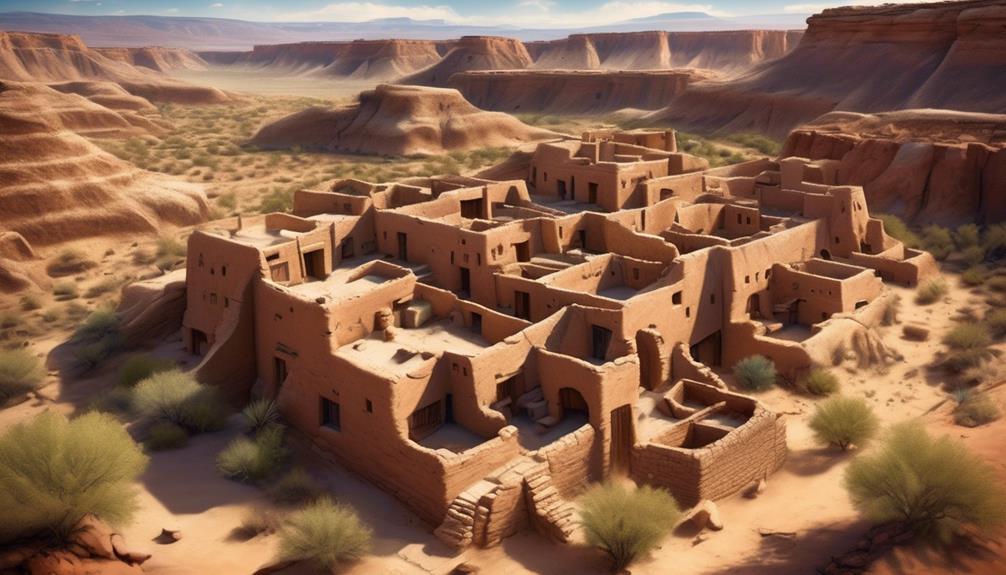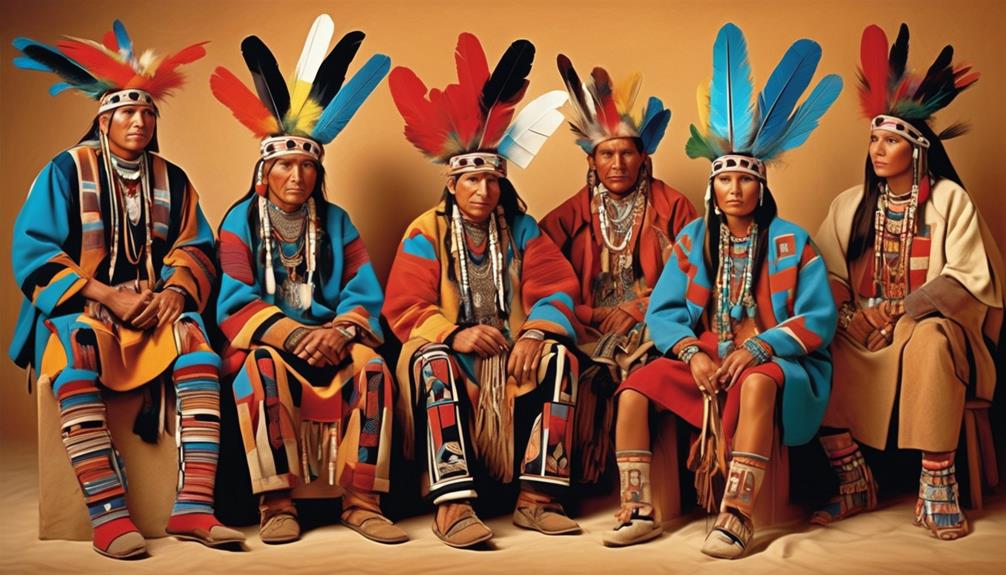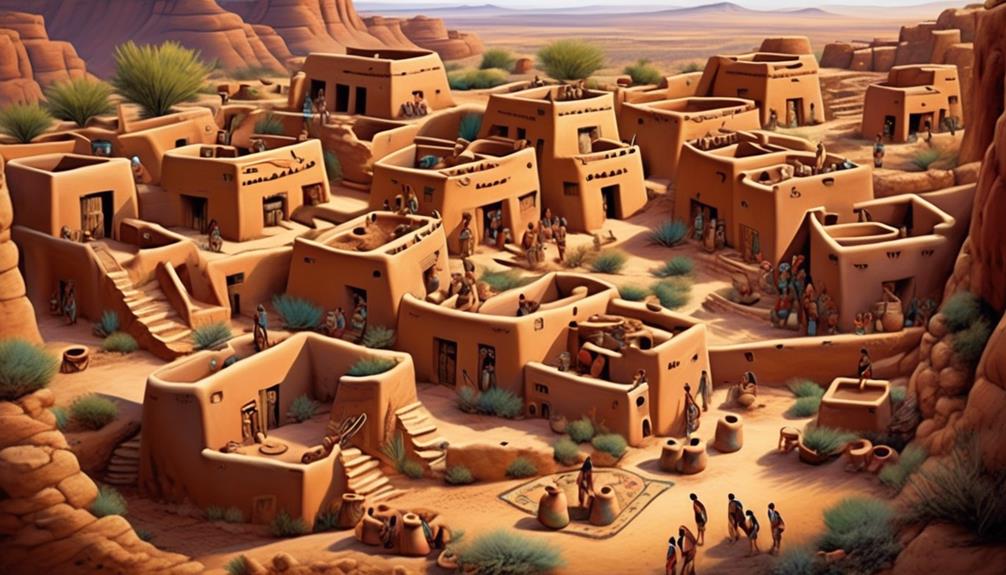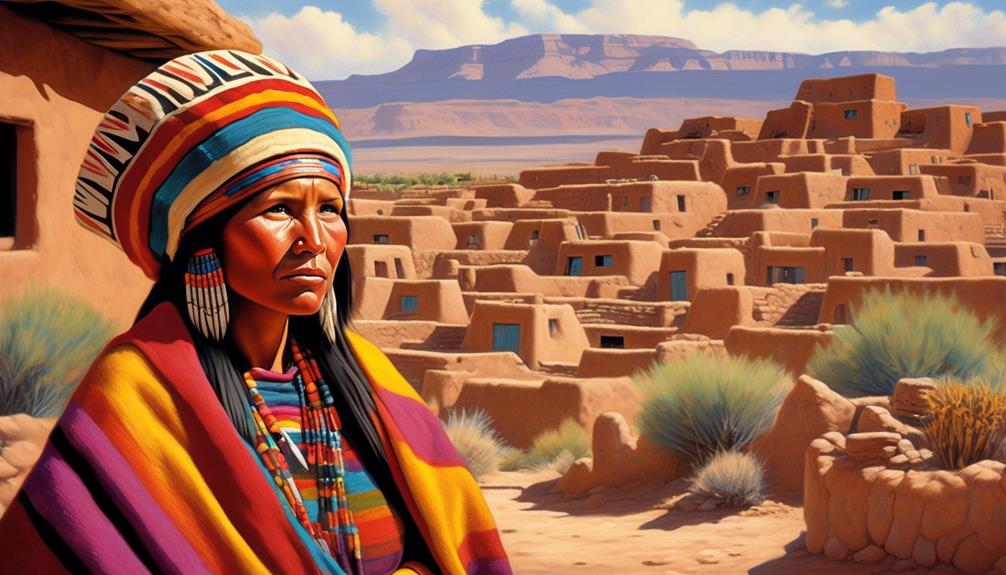Have you ever thought about the exact location of the Hopi tribe’s homes? There are various theories and speculations regarding the original settlements of the Hopi tribe, a subject that still captivates scholars and historians.
The Hopi tribe's history is rich and complex, with a deep connection to the land they have inhabited for centuries. Exploring the origins of their settlements unveils not only their physical location but also sheds light on their unique cultural practices and traditions.
What we uncover may challenge our preconceptions and offer a deeper understanding of the Hopi tribe's enduring legacy.
Key Takeaways
- Hopi settlements date back to around 500-700 AD and are located in the mesas of northeastern Arizona.
- The mesas and plateaus of northeastern Arizona provided natural defense and observation points for the Hopi people.
- Hopi villages are intricately linked to their cultural tapestry and spiritual beliefs, and each village holds significance in Hopi cultural identity.
- Hopi agricultural practices are rooted in ancestral traditions, with an emphasis on crop diversity and ceremonial agriculture.
Early Hopi Settlements
During our exploration of early Hopi settlements, we discovered several remarkable archaeological sites that offer valuable insights into the ancient history and cultural development of the Hopi people.
These settlements, dating back to around 500-700 AD, reveal the fascinating story of the Hopi migration and the development of their ancient dwellings. The Hopi people, believed to be descendants of the Ancestral Puebloans, migrated to the mesas of northeastern Arizona, where they established their unique villages.
The ancient dwellings found in these settlements, such as the iconic multistoried stone structures of the Hopi, known as 'pueblos,' reflect the advanced architectural and engineering skills of the Hopi ancestors. These sites also provide evidence of the Hopi's complex social and religious systems, as well as their rich artistic traditions, including pottery and basketry.
The study of these early settlements has been instrumental in understanding the cultural continuity and resilience of the Hopi people over the centuries, shedding light on their deep connection to the land and their enduring traditions.
Mesas and Plateaus

Nestled atop the rugged mesas and plateaus of northeastern Arizona, the Hopi people established their enduring villages, embodying a rich cultural tapestry woven into the very fabric of the land. The unique mesa geography provided natural defense against intruders and a vantage point for observing the movement of neighboring tribes. The Hopi villages, known for their intricate stone masonry and adobe architecture, were built upon these elevated plateaus, fostering a sense of communal security and preservation of their cultural heritage.
| Mesa Geography | Tribal Migrations |
|---|---|
| The mesas and plateaus of northeastern Arizona provided natural defense and observation points for the Hopi people. | The Hopi people migrated across the mesas and plateaus, settling in villages that reflected their deep spiritual and cultural connection to the land. |
The tribal migrations across the mesas and plateaus were not merely movements from one place to another, but rather deliberate choices deeply rooted in spiritual beliefs and the preservation of traditions. Each village held significance in the intricate web of Hopi cultural identity, representing the continuity of their ancestral ties to the land and the enduring legacy of their people.
Villages and Clans
The enduring villages of the Hopi people, perched atop the rugged mesas and plateaus of northeastern Arizona, are intricately linked to their rich cultural tapestry and spiritual beliefs, with each village bearing significance in the intricate web of Hopi cultural identity. Our ancestral homes, known as pueblos, have been inhabited for over a millennium, serving as the heart of our social structure. The villages aren't just physical dwellings, but living manifestations of our heritage, each with its own ceremonies, traditions, and clans that contribute to the cohesion of the Hopi society.
The social structure of the Hopi people is deeply intertwined with the layout of our villages. Each village is composed of multiple clans, and each clan holds a specific role within the community. These clans are organized based on matrilineal descent, and through this structure, the Hopi people maintain a strong sense of identity and unity.
The villages and clans also play a crucial role in the preservation of our oral history and traditions, ensuring that the legacy of our ancestors remains alive in our daily lives.
Agricultural Practices

Rooted in our ancestral traditions and closely intertwined with the cycles of nature, our agricultural practices have sustained the Hopi people for generations, shaping our cultural identity and fostering a deep connection to the land. Our traditional farming methods, passed down through oral tradition, emphasize the significance of sustainable agriculture in preserving our way of life.
Here are three essential aspects of our agricultural practices:
- Dry Farming Techniques: Our ancestors developed ingenious techniques to cultivate crops in arid environments, such as the construction of terraced fields and the use of hand-dug ditches to capture and retain scarce rainfall.
- Crop Diversity: We maintain a diverse range of native crops, including corn, beans, and squash, which aren't only vital for sustenance but also hold spiritual significance, embodying the essence of our cultural heritage.
- Ceremonial Agriculture: Our agricultural calendar is intertwined with ceremonial practices, emphasizing the holistic connection between the natural world and our community, ensuring that our farming practices remain deeply rooted in tradition and spirituality.
These agricultural practices not only sustain our physical well-being but also serve as a testament to our enduring cultural resilience and reverence for the land.
Contemporary Hopi Communities
In today's modern era, contemporary Hopi communities reflect a dynamic blend of traditional values and the influences of the wider world. They embody the resilience and adaptability of our people. The modern lifestyle has inevitably made its way into our communities, with technological advancements, educational pursuits, and diverse career opportunities becoming integral parts of our lives.
However, amidst these contemporary elements, the commitment to cultural preservation remains unwavering. Our villages continue to uphold age-old traditions, ceremonies, and artistic practices, serving as bastions of our rich heritage. Elders pass down ancestral knowledge to younger generations, ensuring that our customs and beliefs endure the test of time.
The harmonious coexistence of tradition and modernity is evident in the architecture, where traditional adobe homes stand alongside modern structures. Community gatherings, such as the annual Hopi festivals and ceremonies, provide occasions for us to celebrate our cultural identity while also embracing the broader world.
Through this delicate balance, contemporary Hopi communities stand as testaments to our ability to adapt while safeguarding the essence of who we are.
Frequently Asked Questions
What Are the Traditional Hopi Beliefs and Ceremonies Associated With Their Early Settlements?
Traditional Hopi beliefs and ceremonies are deeply intertwined with their early settlements. Hopi ceremonies, rooted in agricultural practices, reflect the tribe's spiritual connection to the land. These rituals are crucial for contemporary preservation of their cultural identity.
Social structures, village roles, and mesa living adaptations are all integral parts of their traditional beliefs. The Hopi people's reverence for their ancestral lands and their commitment to maintaining their way of life are evident in their ceremonies and practices.
How Did the Hopi Tribe Adapt to the Challenges of Living on Mesas and Plateaus?
Living on mesas presented unique challenges for the Hopi tribe. Adapting to the harsh environment and limited resources required ingenuity and resilience.
Our ancestors developed terraced farming techniques, utilizing every inch of arable land. They also constructed elaborate irrigation systems to capture and conserve precious water.
These adaptations not only sustained our community for centuries but also fostered a deep spiritual connection to the land, shaping our cultural identity.
What Are the Social Structures and Roles Within Hopi Villages and Clans?
Social structures within Hopi villages are intricate, with distinct clan roles shaping our community. Traditional beliefs and ceremonial practices underpin our social fabric, fostering unity and harmony.
Each clan plays a vital role in maintaining our cultural identity and upholding our ancestral customs. The interwoven relationships within our villages are guided by a deep reverence for our heritage, ensuring the preservation of our sacred traditions for future generations.
Can You Provide More Details About the Specific Agricultural Practices and Techniques Used by the Hopi Tribe?
Agricultural techniques among the Hopi were vital, reflecting our deep connection to the land. Our farming methods, like dry farming and terrace agriculture, were influenced by our beliefs and environment. We adapted to the arid climate, using irrigation and crop rotation.
Hopi social structures supported communal work and resource sharing, essential for successful agriculture. Our practices sustained us for generations, embodying the harmony between our beliefs and agricultural livelihood.
How Have Contemporary Hopi Communities Preserved and Adapted Traditional Practices in the Modern World?
Preservation of traditional Hopi practices in modernity is a testament to our community's resilience. Through cultural adaptation, we uphold our agricultural heritage, ensuring sustainability.
We integrate ancient wisdom with contemporary methods, safeguarding our rituals and language. Our dedication to preserving ceremonial dances and clan traditions fosters a strong sense of identity.
Conclusion
After centuries of migration and hardship, we, the Hopi people, have settled in the mesas and plateaus of northeastern Arizona. Our villages and clans are rooted in ancient traditions, and our agricultural practices sustain our communities.
While some may question our choices to remain in this arid region, our connection to the land and our deep cultural heritage make it worth the challenges. Our contemporary Hopi communities continue to thrive and preserve our rich history and traditions.









